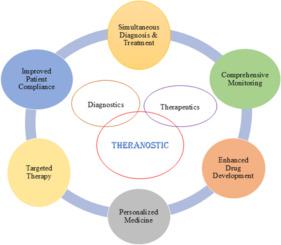结合分子成像与近红外治疗提高阿尔茨海默病的早期发现和治疗。
IF 4.7
2区 医学
Q1 BIOCHEMISTRY & MOLECULAR BIOLOGY
引用次数: 0
摘要
阿尔茨海默病(AD)由于其无症状的前症期和多方面的病理生理,包括以过度磷酸化tau的神经原纤维缠结(nft)为特征的淀粉样蛋白-β (a β)斑块,仍然是一个重要的未满足的临床需求。传统的诊断方法,如磁共振成像(MRI)和正电子发射断层扫描(PET),只有在广泛的神经元丢失后才能检测到AD。化学生物学的最新进展使多功能小分子治疗探针的创造成为可能,它将诊断成像与治疗干预相结合。本文综述了新型探针的设计和分子工程,特别是近红外(NIR)染料、芳基喹啉、基于花青素的荧光团和姜黄素衍生物,它们对Aβ和tau聚集体具有高度特异性,能有效地穿透血脑屏障(BBB),并适用于多模态成像,包括近红外成像(NIR)荧光、MRI、PET。这些探针通常含有供体-受体基序,并表现出对环境敏感的荧光,允许病理蛋白质聚集的实时成像。此外,我们考虑了双模式探针,如PiB-C和BTTA,它们将金属螯合治疗与成像结合起来,提供了一种有针对性的方法来分解a β斑块,同时显示治疗效果。通过合成化学、分子成像和神经治疗的结合,这种跨学科的方法为早期阿尔茨海默病的检测和治疗提供了一个有希望的新范例。这些小分子疗法的发展为神经退行性疾病的个性化治疗提供了新的机会。本文章由计算机程序翻译,如有差异,请以英文原文为准。

Integrating molecular imaging with near-infrared theranostics to improve early detection and therapy of Alzheimer's disease
Alzheimer's disease (AD) remains a significant unmet clinical need due to its asymptomatic prodromal phase and multifaceted pathophysiology, which comprises amyloid-β (Aβ) plaques characterized by neurofibrillary tangles (NFTs) of hyperphosphorylated tau. Conventional diagnostic methods, such as magnetic resonance imaging (MRI) and positron emission tomography (PET), detect AD only after extensive neuronal loss. Recent progress in chemical biology has enabled the creation of multifunctional small-molecule theranostic probes that integrate diagnostic imaging with therapeutic intervention. This review emphasizes the design and molecular engineering of new probes in particular, near-infrared (NIR) dyes, aryl quinolines, cyanine-based fluorophores, and curcumin derivatives, which are highly specific for Aβ and tau aggregates, penetrate the blood-brain barrier (BBB) effectively, and are amenable to multimodal imaging including near-infrared imaging (NIR) fluorescence, MRI, PET. These probes commonly contain donor-acceptor motifs and exhibit environment-sensitive fluorescence, allowing for the real-time imaging of pathological protein aggregation. Furthermore, we consider dual-mode probes, such as PiB-C and BTTA, which combine metal chelation therapy with imaging, providing a targeted approach to disaggregate Aβ plaques concurrently visualizing therapeutic effectiveness. Through the combination of synthetic chemistry, molecular imaging, and neurotherapeutics, this transdisciplinary approach outlines a promising new paradigm for early AD detection and treatment. The development of these small-molecule theranostics presents new opportunities for personalized medicine in treating neurodegenerative diseases.
求助全文
通过发布文献求助,成功后即可免费获取论文全文。
去求助
来源期刊

Bioorganic Chemistry
生物-生化与分子生物学
CiteScore
9.70
自引率
3.90%
发文量
679
审稿时长
31 days
期刊介绍:
Bioorganic Chemistry publishes research that addresses biological questions at the molecular level, using organic chemistry and principles of physical organic chemistry. The scope of the journal covers a range of topics at the organic chemistry-biology interface, including: enzyme catalysis, biotransformation and enzyme inhibition; nucleic acids chemistry; medicinal chemistry; natural product chemistry, natural product synthesis and natural product biosynthesis; antimicrobial agents; lipid and peptide chemistry; biophysical chemistry; biological probes; bio-orthogonal chemistry and biomimetic chemistry.
For manuscripts dealing with synthetic bioactive compounds, the Journal requires that the molecular target of the compounds described must be known, and must be demonstrated experimentally in the manuscript. For studies involving natural products, if the molecular target is unknown, some data beyond simple cell-based toxicity studies to provide insight into the mechanism of action is required. Studies supported by molecular docking are welcome, but must be supported by experimental data. The Journal does not consider manuscripts that are purely theoretical or computational in nature.
The Journal publishes regular articles, short communications and reviews. Reviews are normally invited by Editors or Editorial Board members. Authors of unsolicited reviews should first contact an Editor or Editorial Board member to determine whether the proposed article is within the scope of the Journal.
 求助内容:
求助内容: 应助结果提醒方式:
应助结果提醒方式:


